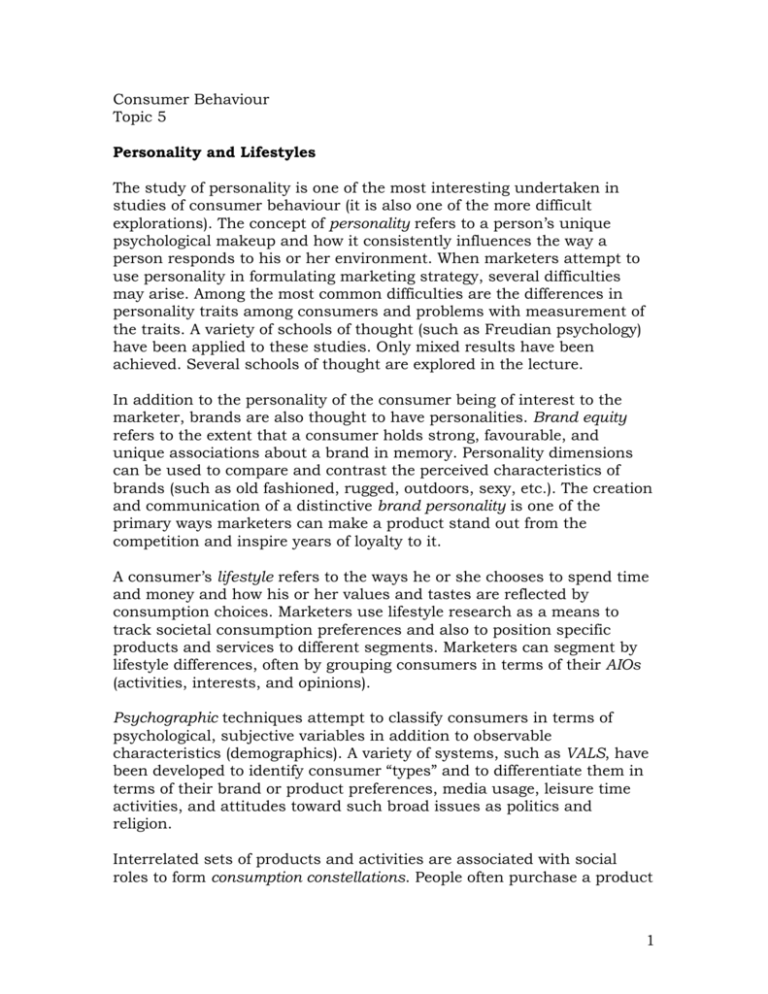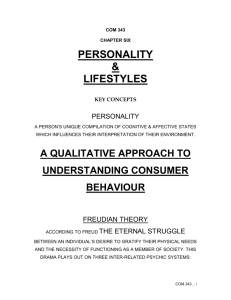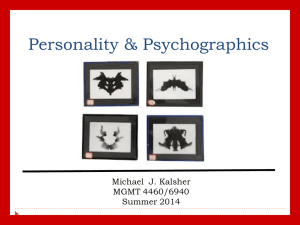Consumer Behaviour
advertisement

Consumer Behaviour Topic 5 Personality and Lifestyles The study of personality is one of the most interesting undertaken in studies of consumer behaviour (it is also one of the more difficult explorations). The concept of personality refers to a person’s unique psychological makeup and how it consistently influences the way a person responds to his or her environment. When marketers attempt to use personality in formulating marketing strategy, several difficulties may arise. Among the most common difficulties are the differences in personality traits among consumers and problems with measurement of the traits. A variety of schools of thought (such as Freudian psychology) have been applied to these studies. Only mixed results have been achieved. Several schools of thought are explored in the lecture. In addition to the personality of the consumer being of interest to the marketer, brands are also thought to have personalities. Brand equity refers to the extent that a consumer holds strong, favourable, and unique associations about a brand in memory. Personality dimensions can be used to compare and contrast the perceived characteristics of brands (such as old fashioned, rugged, outdoors, sexy, etc.). The creation and communication of a distinctive brand personality is one of the primary ways marketers can make a product stand out from the competition and inspire years of loyalty to it. A consumer’s lifestyle refers to the ways he or she chooses to spend time and money and how his or her values and tastes are reflected by consumption choices. Marketers use lifestyle research as a means to track societal consumption preferences and also to position specific products and services to different segments. Marketers can segment by lifestyle differences, often by grouping consumers in terms of their AIOs (activities, interests, and opinions). Psychographic techniques attempt to classify consumers in terms of psychological, subjective variables in addition to observable characteristics (demographics). A variety of systems, such as VALS, have been developed to identify consumer “types” and to differentiate them in terms of their brand or product preferences, media usage, leisure time activities, and attitudes toward such broad issues as politics and religion. Interrelated sets of products and activities are associated with social roles to form consumption constellations. People often purchase a product 1 or service because it is associated with a constellation that, in turn, is linked to a lifestyle they find desirable. Place of residence often is a significant determinant of lifestyle. Many marketers recognize regional differences in product preferences and develop different versions of their products for different markets. A set of techniques called geodemography analyzes consumption patterns using geographical and demographic data and identifies clusters of consumers who exhibit similar psychographic characteristics. The lecture concludes by discussing lifestyle trends with respect to consumer behaviour for the new millennium. These major trends are characterized as being: concern for the environment, an emphasis on the value of time-saving products, decreased emphasis on dieting and nutritional foods, and a more relaxed lifestyle and casual work environment. Lecture Overview 1. Personality a. Personality refers to a person’s unique psychological makeup and how it consistently influences the way a person responds to his or her environment. 1) There has been debate about whether personality changes with situations and circumstances. a) Do people appear to act consistently? Research results are mixed. 2) Even though inconsistencies have been found in personality research, it still continues to be included in marketing strategies. 3) Personality dimensions are usually employed in concert with a person’s choices of leisure activities, political outlook, aesthetic tastes, and other individual factors to segment consumers in terms of lifestyles. 2. Consumer Behaviour: Freudian Theory a. Sigmund Freud developed the idea that much of one’s adult personality stems from a fundamental conflict between a person’s desire to gratify his or her physical needs and the necessity to function as a responsible member of society. His principles (note that these terms do not refer to physiological portions of the consumer’s brain) included: 1) The id (which is entirely oriented toward immediate gratification). It operates on the pleasure principle (behaviour guided by the primary desire to maximize pleasure and avoid pain). a) The id is selfish. b) The id is illogical (it acts without regard to consequences). 2 2) The superego (which is the counterweight to the id). It is a person’s conscience. a) It internalizes society’s rules. b) It works to prevent the id from seeking selfish gratification. 3) The ego (which is the system that mediates between the id and the superego). The ego tries to balance these two opposing forces according to the reality principle, whereby it finds ways to gratify the id that will be acceptable to the outside world. Much of this battle occurs in the unconscious mind. b. The Freudian perspective hints that the ego relies on symbolism in products to make the compromise between the demands of the id and the prohibitions of the superego. c. There is a connection between product symbolism and motivation (according to Freudian theory). d. The first attempts to apply Freudian ideas to understand the deeper meanings of products and advertisements were made in the 1950s and were known as motivational research. 1) This research focused on interpretations from the subconscious (unconscious motives). This form of research relies on depth interviews with individual consumers. 2) Ernest Dichter pioneered this form of interview. 3) Motivational research was attacked for two reasons: a) Some felt that it does work, in fact, it worked too well. It gave marketers the power to manipulate. b) Others felt that the analysis technique lacked rigor and validity. 4) Positives were that: a) It was less expensive than traditional forms of motivational research. b) It was thought to aid in marketing communications. c) Some of the findings seem intuitively plausible after the fact. Neo-Freudian Theories e. Those who studied after Freud felt that an individual’s personality was more influenced by how he or she handled relationships with others than by unresolved sexual conflicts. Famous advocates of this thoughtpath (Neo-Freudians) were: 1) Karen Horney—she proposed that people can be described as moving toward others (compliant), away from others (detached), or against others (aggressive). a) Alfred Adler—proposed that many actions are motivated by people’s desire to overcome feelings of inferiority relative to others. b) Harry Stack Sullivan—focused on how personality evolves to reduce anxiety in social relationships. 3 2) Carl Jung—developed analytical psychology. He believed people were shaped by the cumulative experiences of past generations. Central to his ideas was the collective unconscious (a storehouse of memories inherited from our ancestral past). a) Shared memories create archetypes— universally shared ideas and behaviour patterns. b) These memories would be about birth, death, and the devil (as shown in myths, stories, and dreams). Trait Theory f. One approach to personality is to focus on the quantitative measurement of traits or identifiable characteristics that define a person. Common traits are: 1) Extroversion 2) Innovativeness 3) Materialism 4) Self-consciousness 5) Need for cognition g. The trait dimension most relevant to consumer behaviour is the extent to which consumers are inner-directed versus outer-directed. 1) Inner-directed individuals consume to express a unique sense of self and tend to be classified as idiocentrics (having an individualistic orientation). 2) Outer-directed individuals consume to please others and fit in and tend to be classified as allocentrics (having a group orientation). 3) These two orientations differ in the areas of contentment, health consciousness, food preparation, work, travel, and entertainment. g. Using traits has only met with mixed success. Explanations include: 1) Many of the scales are not sufficiently valid or reliable. 2) Personality tests are often developed only for specific populations. 3) Tests may not be administered under the best conditions. 4) Researchers make changes in the research instruments to adapt them to their own situations. 5) Many trait scales are only intended to measure gross, overall tendencies. 6) Many of the scales are not well planned or thought out. Brand Personality h. Products, like consumers, have personalities. 1) Brand equity refers to the extent that a consumer holds strong, favourable, and 4 unique associations about a brand in memory. Examples of personality dimensions include old fashioned, wholesome, traditional, and lively, among others. 2) Consumers seem to have little difficulty in assigning personality qualities to all sorts of inanimate products. 3) The creation and communication of a distinctive brand personality is one of the primary ways marketers can make a product stand out from the competition and inspire years of loyalty to it. This is called animism (whereby inanimate objects are given qualities that make them somehow alive). It is an old practice. Types include: a) Level 1: In the highest order of animism, the object is believed to be possessed by the soul of a being (such as spokespersons in advertising). b) Level 2: Objects are anthropomorphized—given human characteristics. 3. Lifestyles and Psychographics Lifestyle: Who We Are, What We Do a. Lifestyle refers to a pattern of consumption reflecting a person’s choices of how he or she spends time and money. It is (in an economic sense) how one elects to allocate income. 1) A lifestyle marketing perspective recognizes that people sort themselves into groups on the basis of the things they like to do, how they like to spend their leisure time, and how they choose to spend their disposable income. 2) These choices create marketing opportunities and chances for segmentation. 3) Lifestyles can be thought of as group identities. It is more than economics and income disposal choices. a) Lifestyle is a statement of who one is and who one is not. b) Other terms used to describe lifestyle are: 1. Taste public 2. Consumer group 3. Symbolic community 4. Status culture c) Lifestyles are not set in stone unlike deep-seated values. b. Products are the building blocks of lifestyles. Many choices are made on this basis. c. Because a goal of lifestyle marketing is to allow consumers to pursue their chosen ways to enjoy their lives and express their social identities, a key aspect of this strategy is to focus on product usage in desirable social settings. 5 d. The adoption of a lifestyle-marketing perspective implies that we must look at patterns of behaviour to understand consumers. 1) Co-branding strategies are used by marketers to combine products that appeal to similar patterns of behaviour. 2) Product complementarity occurs when the symbolic meanings of different products are related to each other. 3) These products, termed consumption constellations, are used by consumers to define, communicate, and perform social roles. Psychographics e. Psychographics involves the use of psychological, sociological, and anthropological factors to determine how the market is segmented by the propensity of groups within the market (and their reasons) to make a particular decision about a product, person, ideology, or otherwise hold an attitude or use a medium. 1) Psychographics can help a marketer fine-tune its offerings to meet the needs of different segments. 2) The roots of psychographics were in: a) Motivational research, which involves intensive one-to-one interviews and projective tests (yields a lot of information on a few people). b) Quantitative survey research (at the other extreme), which uses large-scale demographic research techniques. 3) Psychographics is often used interchangeably with lifestyle. 4) Psychographics focuses on why people buy. Demographics tells us who buys. 5) Psychographic analysis can take several forms: a) A lifestyle profile b) A product-specific product c) A study that uses personality traits as descriptors d) A general lifestyle segmentation e) A product-specific segmentation f. Most contemporary psychographic research attempts to group consumers according to some combination of three categories of variables—Activities, Interests, and Opinions (AIOs). 1) To group consumers into common AIO categories, respondents are given a long list of statements and are asked to indicate how much they agree with each one. Lifestyle is “boiled down” by how consumers spend their time, what they find interesting and important, and how they view themselves and the world around them, as well as demographic information. 2) Which lifestyle segments produce the bulk of consumers? This is answered (marketers must be careful to observe) by the 20/80 6 principle where only 20 percent of a product’s users account for 80 percent of the volume of the product sold (in other words, the heavy users). 3) After “heavy users” are identified and understood, the brand’s relationship to them is considered. g. Uses of psychographic segmentation include: 1) To define the target market 2) To create a new view of the market 3) To position the product 4) To better communicate product attributes 5) To develop overall strategy 6) To market social and political issues h. Many research companies and advertising agencies have developed segmentation typologies that divide people into segments. Because these are largely proprietary however, they are hard to get. i. One well-known and widely used segmentation system is VALS (Values and Lifestyles), developed at what is now SRI International in California. Nine lifestyle clusters have been identified. VALS2 extends this concept and uses eight groups that are determined by psychological characteristics and “resources” (such as income, education, energy levels, and eagerness to buy). The groups include: 1) 2) 3) 4) 5) 6) approval. 7) 8) Actualizers—successful with many resources open to change. Fulfilled—satisfied, reflective, comfortable, practical. Achievers—career-oriented, avoid risk, self-discovery. Experiencers—impulsive, young, offbeat, love risk. Believers—strong principles, favor proven brands. Strivers—like achievers, but with fewer resources, need Makers—action-oriented, self-sufficiency, do-it-yourselfers. Strugglers—bottom-of-the-ladder, immediate gratification. j. Global MOSAIC is another segmentation system that has developed fourteen common lifestyles that apply across cultures. k. A Paris-based organization called RISC has developed a segmentation system that seeks to anticipate future change in social climate around the world and to identify signs of change in one country before it eventually spreads to others. 1) RISC measures the social climate in more than forty countries. 2) The RISC system asks a battery of questions that measure forty “trends.” 7 3) The system places people in a virtual space described by three axes— exploration/stability, social/individual, and global/local. 4) Individuals fit into one of ten general category segments in this virtual space. Regional Consumption Differences j. Consumption patterns change as one moves from one region of their country to another. Differences occur in: 1) Food preferences. A food culture is a pattern of food and beverage consumption that reflects the values of a social group. 2) The arts and entertainment. 3) Geodemography. a) Geodemography refers to analytical techniques that combine data on consumer expenditures and other socioeconomic factors with geographic information about the areas in which people live in order to identify consumers who share common consumption patterns. “Birds of a feather flock together.” b) Cluster analysis allows marketers to identify consumers who share important characteristics. c) Single-source data is where a person’s actual purchasing history is combined with geo-demographic data. d) One method that is used is PRIZM (Potential Rating Index by Zip Market). End. 8








